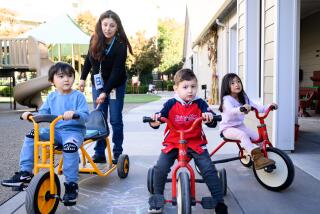Parenting : Keeping Those Bullies at Bay : * Wringing their necks is not the solution. Families and teachers can help children avoid being targeted.
- Share via
The neighborhood bullies are picking on little Ryan Wright, 6.
The ruffians--some of whom are twice Ryan’s age--pursue the youngster on bikes. They pretend to run him over. When he goes out to play, they order him indoors and chase his friends home.
“It infuriates me,” said Ryan’s mother, Denise Wright of Saugus. “I feel like wringing their necks. I want to go out there and handle it, but I can’t fight my kids’ battles. I don’t want them to rely on me because I am not always going to be there.”
Obviously, wringing the little monsters’ necks is not the solution (tempting though it may be). And while youngsters often work out their differences on their own, parents and teachers can take steps to help children avoid being the target of bullies.
Wright, for example, attempts to strengthen her children’s character. “I teach my kids to verbally fight back,” she said. “Ryan is getting tougher. He used to come in crying all the time, but he is learning to acquire a ‘back off; you are not going to walk on me’ attitude.”
Kids who are regularly pounded on by other children are likely to suffer from low self-confidence--which in turn makes them even more vulnerable to attacks, according to Loeb Aronin, director of psychological services for the Los Angeles Unified School District.
“Parents need to build their child’s self-esteem,” he said. “Compliment your youngsters; continually praise them; show them the areas they are skilled at; tell them how important they are.”
Aronin also recommends that parents allow their children to wear the clothing and hair styles popular among their peers. “Kids who stand out physically are targets,” he said. “Let your kids fit in.”
It is easy to spot children who are chronically harassed, according to Martha Mutz, principal of Bay Laurel School in Calabasas. “Kids who get upset when they are put down, kids who get overly hurt, kids who are sensitive are identified pretty early on,” she said. “They don’t have internal strength, and they believe the put-downs. It’s almost like they are wearing a T-shirt that says ‘I am the victim.’ ”
Mutz often invites such children to her office to practice building their self-esteem. “I have them write things like, ‘I am strong,’ ” she said. “If they get teased about their name, I have them write, ‘I like my name.’ We rehearse comebacks like ‘buzz-off; get away from me; get out of here.’ I teach them to say it loud and clear, in a firm way.”
But children who repeatedly find themselves on the receiving end of a bigger kid’s wrath say such tactics do not always work. “Bullies are really strong, and they want to hurt people,” said Johnny Tredent, 9, a Bay Laurel third-grader. “Like this girl, she trips me, pushes me, kicks me. I say, ‘Please stop it. I don’t like it.’ But there is no possible way she will stop. I am just going to have to get through it.”
*
Aronin believes that schools have a responsibility to end chronic bullying by providing counseling to offenders and their parents. “If this is how the kid learned to win his point, it is likely your child is not the only one who is being picked on,” he said.
He recommends that nonaggressive problem-solving techniques be taught in class and that peer counseling groups be established to resolve conflicts. He also suggests that parents and teachers work together to establish supervised areas on campus; young children can be matched with older “buddies” who keep an eye out for them; and students can walk to classes in groups.
Parental intervention is sometimes called for, as well. Vickie Cardoza of Glendale, for example, encourages her daughters, Jaqueline and Jasmine, to work out their differences with playmates. “But if it keeps up, I take further steps,” she said. “No child should have to put up with verbal or physical abuse from an older kid.”
*
In most cases, all Cardoza has to do is let the offenders know that she is aware of the situation. “When a group of bigger and older girls was ganging up on Jaqueline and giving her a hard time, I went up to them and simply said, ‘I expect you to leave her alone. If I have to talk to your parents, I will.’ The harassment stopped,” she said.
Bay Laurel fifth-grader Peter Young, 11, admits that he used to pick on other kids. “Whenever something little happened, I would get really, really mad,” he said. “I just lost my mind and went after them. It was almost like I had a psycho brain.”
Now reformed, Peter carries a card that reads “I’m sorry” to remind him that he may regret it if he harasses someone who annoys him. Why the turnaround?
“My dad said if he hears bad reports on me, I will be suspended from using my Roller Blades,” he said.
More to Read
Sign up for Essential California
The most important California stories and recommendations in your inbox every morning.
You may occasionally receive promotional content from the Los Angeles Times.













